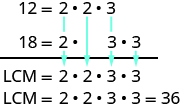Finding the Least Common Multiple of Two Numbers
Learning Outcomes
- Find the least common multiple of two numbers by listing multiples
- Find the least common multiple of two numbers by prime factorization
Listing Multiples Method
A common multiple of two numbers is a number that is a multiple of both numbers. Suppose we want to find common multiples of [latex]10[/latex] and [latex]25[/latex]. We can list the first several multiples of each number. Then we look for multiples that are common to both lists—these are the common multiples.[latex]\begin{array}{c}10\text{ : }10, 20, 30, 40, 50, 60, 70, 80, 90, 100, 110\ldots \hfill \\ 25\text{ : }25, 50,75, 100, 125\ldots \hfill \end{array}[/latex]
We see that [latex]50[/latex] and [latex]100[/latex] appear in both lists. They are common multiples of [latex]10[/latex] and [latex]25[/latex]. We would find more common multiples if we continued the list of multiples for each. The smallest number that is a multiple of two numbers is called the least common multiple (LCM). So the least LCM of [latex]10[/latex] and [latex]25[/latex] is [latex]50[/latex].Find the least common multiple (LCM) of two numbers by listing multiples
- List the first several multiples of each number.
- Look for multiples common to both lists. If there are no common multiples in the lists, write out additional multiples for each number.
- Look for the smallest number that is common to both lists.
- This number is the LCM.
example
Find the LCM of [latex]15[/latex] and [latex]20[/latex] by listing multiples. Solution: List the first several multiples of [latex]15[/latex] and of [latex]20[/latex]. Identify the first common multiple.[latex]\begin{array}{l}\text{15: }15,30,45,60,75,90,105,120\hfill \\ \text{20: }20,40,60,80,100,120,140,160\hfill \end{array}[/latex]
The smallest number to appear on both lists is [latex]60[/latex], so [latex]60[/latex] is the least common multiple of [latex]15[/latex] and [latex]20[/latex]. Notice that [latex]120[/latex] is on both lists, too. It is a common multiple, but it is not the least common multiple.try it
[ohm_question]145458[/ohm_question]Prime Factors Method
Another way to find the least common multiple of two numbers is to use their prime factors. We’ll use this method to find the LCM of [latex]12[/latex] and [latex]18[/latex]. We start by finding the prime factorization of each number.[latex]12=2\cdot 2\cdot 318=2\cdot 3\cdot 3[/latex]
Then we write each number as a product of primes, matching primes vertically when possible.[latex]\begin{array}{l}12=2\cdot 2\cdot 3\hfill \\ 18=2\cdot 3\cdot 3\end{array}[/latex]
Now we bring down the primes in each column. The LCM is the product of these factors. Notice that the prime factors of [latex]12[/latex] and the prime factors of [latex]18[/latex] are included in the LCM. By matching up the common primes, each common prime factor is used only once. This ensures that [latex]36[/latex] is the least common multiple.
Notice that the prime factors of [latex]12[/latex] and the prime factors of [latex]18[/latex] are included in the LCM. By matching up the common primes, each common prime factor is used only once. This ensures that [latex]36[/latex] is the least common multiple.
Find the LCM using the prime factors method
- Find the prime factorization of each number.
- Write each number as a product of primes, matching primes vertically when possible.
- Bring down the primes in each column.
- Multiply the factors to get the LCM.
example
Find the LCM of [latex]15[/latex] and [latex]18[/latex] using the prime factors method.Answer: Solution:
| Write each number as a product of primes. |  |
| Write each number as a product of primes, matching primes vertically when possible. |  |
| Bring down the primes in each column. |  |
| Multiply the factors to get the LCM. | [latex]\text{LCM}=2\cdot 3\cdot 3\cdot 5[/latex] The LCM of [latex]15\text{ and }18\text{ is } 90[/latex]. |
example
Find the LCM of [latex]50[/latex] and [latex]100[/latex] using the prime factors method.Answer: Solution:
| Write the prime factorization of each number. | [latex]50=2\cdot{5}\cdot{5}\quad\quad\quad{100=2\cdot{2}\cdot{5}\cdot{5}}[/latex] |
| Write each number as a product of primes, matching primes vertically when possible. | [latex]50=\quad{2\cdot{5}\cdot{5}}[/latex] [latex]100=2\cdot{2}\cdot{5}\cdot{5}[/latex] |
| Bring down the primes in each column. |  |
| Multiply the factors to get the LCM. | [latex]\text{LCM}=2\cdot 2\cdot 5\cdot 5[/latex] The LCM of [latex]50\text{ and } 100\text{ is } 100[/latex]. |
try it
[ohm_question]145462[/ohm_question]Contribute!
Did you have an idea for improving this content? We’d love your input.
Licenses & Attributions
CC licensed content, Original
- Question ID: 145462, 145459, 145458. Authored by: Alyson Day. License: CC BY: Attribution. License terms: IMathAS Community License CC-BY + GPL.
CC licensed content, Shared previously
- Example: Determining the Least Common Multiple Using a List of Multiples. Authored by: James Sousa (Mathispower4u.com). License: CC BY: Attribution.
- Example: Determining the Least Common Multiple Using Prime Factorization. Authored by: James Sousa (Mathispower4u.com). License: CC BY: Attribution.
CC licensed content, Specific attribution
- Prealgebra. Provided by: OpenStax License: CC BY: Attribution. License terms: Download for free at http://cnx.org/contents/[email protected].
